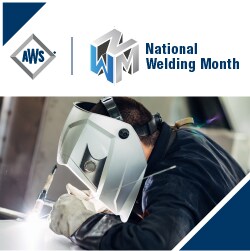 The American Welding Society believes that April should be about taking the time to recognize and reflect on the impact welding has on our daily life, and thus has declared this month to be National Welding Month.
The American Welding Society believes that April should be about taking the time to recognize and reflect on the impact welding has on our daily life, and thus has declared this month to be National Welding Month.
The AWS website notes why it is important to have such a day: “Every day in thousands of shipyards, automotive assembly plants and construction sites, skilled welding professionals are working to build the structures and products on which the American economy depends. These professionals are behind the scenes welding the very backbone of industry and your world. The month of April is a chance to spotlight the welding industry’s past, present and future through education, mentorship and recognition.”
We applaud those individuals and the technologies that not only help build our economy, but also keep us safe. Welding is the joining of two or more materials through heat or heat and pressure, forming a bond between two pieces of metal or plastic. If that bond breaks or if the wrong welding material is used, a catastrophe can happen: airplanes could fall apart in mid-air, cars could crash, and oil and gas pipes could burst and cause explosions.
Before National Welding Month comes to a close, here’ are four previously published welding-related articles and one video:
- Are You Falling Short of 100% PMI Because You Can’t Reach The Welds? –
Identification of metals and alloys is paramount to safety in the oil and gas industry (O&G), especially in downstream processing plants (refining, petrochemical, gas processing). There are brackets and bolts and screws and clips and all the welding that goes with it to keep the pipes and other components connected. And all those components, including the welding materials, must be made of the right metals and alloys. Read about weld failures, how the sheer number of welds can be overwhelming, and how to reach the weld in order to analyze it. - Pressure Retaining Welds: Its What’s On The Inside That Counts –
Most construction projects that include fabricating piping spools, pressure vessels, heat exchangers and other pressure retaining equipment require multiple passes of filler metal to join two base materials together. This procedure is to ensure the material joining process proposed for construction is capable of producing joints having the required mechanical properties for the intended application and produce a sound weld. Find out what happens if inappropriate filler metal is applied. - PMI Testing of 347 Stainless Steel: As-Delivered vs. As-Welded –
In this article, we show an example of PMI testing of a 347 stainless steel FCAW (Flux Core Arc Welding) spool in the as-delivered condition vs. the as-welded condition. FCAW is an automatic or semi-automatic welding process using a tubular wire that is filled with a flux throughout its inner core. Read the test results and what happened to the Niobium. - Weld Metal Analysis: Fine Tune Your PMI Protocol –
The chemical composition of the electrode wire and flux core, in combination with the shielding gas, will determine the weld metal composition and mechanical properties of the weld. In many cases these additional alloying elements will not be seen when performing positive material identification (PMI) testing on the weld metal spool directly. Some examples of this type of testing in stainless steel weld material could yield the absence of key stabilizing elements necessary to provide the mechanical properties for its intended application, like the absence of Molybdenum (Mo) in 316ss or the absence of Niobium (Nb) in 347ss. - Video: Acuren Inspection –
PMI Manager discusses how portable XRF analyzers with smaller windows are especially important for their ability to ‘shoot smaller welds’ because if too much base material is included, you won’t get accurate readings. (1:15 mark)
We join AWS in its celebration of National Welding Month.






Leave a Reply